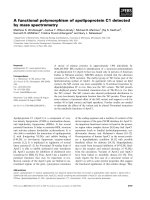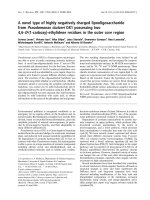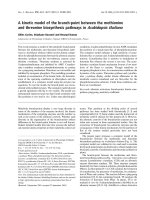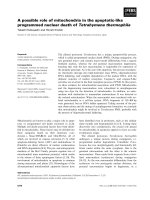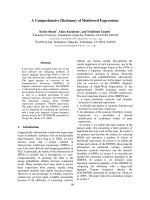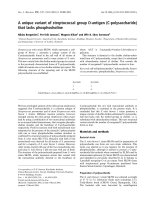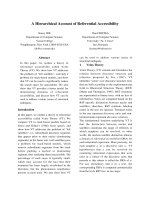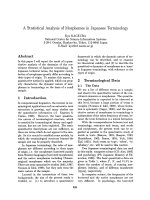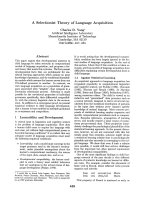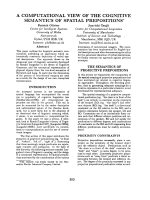Báo cáo khoa học: "A Computational Treatment of Korean Temporal Markers, OE and DONGAN" pptx
Bạn đang xem bản rút gọn của tài liệu. Xem và tải ngay bản đầy đủ của tài liệu tại đây (54.02 KB, 8 trang )
A Computational Treatment of Korean Temporal Markers,
OE and DONGAN
Hyunjung Son
EHESS
54, Boulevard Raspail
75006 Paris France
Abstract
In this paper, we elucidate how Korean
temporal markers, OE and DONGAN
contribute to specifying the event time
and formalize it in terms of typed lambda
calculus. We also present a computational
method for constructing temporal
representation of Korean sentences on the
basis of G grammar proposed by [Renaud,
1992;1996].
1 Introduction
Associated to a NP, Korean temporal markers OE
and DONGAN build time adverbials.
(1) ach’im ilgopshiOE
morning/seven o’clock-OE
at seven o’clock in the morning
(2) han shigan DONGAN
one/hour/DONGAN
for an hour
As it is widely known, time adverbials play
important roles in sentence meaning processing.
Meanwhile, there is a significant divergence in
opinions whether time adverbials or tense/aspect is
a more efficient indicator leading to a correct
temporal representation of sentences. To some
[Kim, 1981], [Jo, 2000], [Vet, 1980], [Verkyul,
1989], tense or aspect is the only credible index to
consult in establishing temporal interpretation, and
the time adverbials are complementary. To others
[Renaud, 1996], [Vlach, 1993], time adverbials are
regarded as much more reliable than tense/aspect
which is too ambiguous to provide coherent
instructions about how to locate the event in time.
We agree with the second point of view, as we
observed that Korean tense markers fail to provide
a solid and coherent way to capture the relevant
time span. For example, the verbal infix ‘-at-’,
generally considered as a typical past tense marker
in Korean, brings about several time interpretation
possibilities such as simple past (3), completion
(4), resultant state (5) and progressiveness (6).
(3) shiwidaega ôje hanshiOE shich’ôngul
dulrôssatta
demonstrators-NOM / yesterday /one o’clock-OE /
the city hall-ACC/ surround-PA-DEC
1
The demonstrators surrounded the city hall at one
o’clock yesterday.
(4) shiwidaega mach’imnae shich’ôngul
dulrôssatta
demonstrators-NOM / at last / the city hall-ACC
/surround-PA-DEC
At last, the demonstrators surrounded (succeeded
in surrounding) the city hall.
(5) shiwidaega harudongan shich’ôngul
dulrôssatta
demonstrators-NOM/one day-DUR/the city hall-
ACC/surround-PA-DEC
The demonstrators have surrounded the city hall
for one day.
1
We used the McCune-Reischauer system to transcribe
the Korean data. For glossing grammatical morphemes,
we use the following abbreviations:
ACC: accusative, AS: attributive suffix, CIRCUM:
circumstantial, CL: classifier, DEC: declarative, DUR:
durative, INT: interrogative, LOC: locative, NOM:
nominative, NS: nominal suffix, PA: past, TOP:topic.
(6) ônjebutô shiwidaega shich’ôngul
dulrôssatssumnikka?
since when/ demonstrators-NOM/ the city hall-
ACC/ surround-PA-INT
Since when have the demonstrators been
surrounding the city hall?
Moreover, what triggers these interpretation
possibilities is still being discussed among Korean
linguists
2
.
In the following, we attempt to show how time
adverbials can remedy this shortcoming and
specify the event time.
2 Semantic description
The assumption underlying our temporal
description is that the linguistic time is ordered,
discrete, infinite and consisting of instants
corresponding to the natural numbers. The
linguistic time can be expressed with one of these
three notions: instant, extended interval and
duration. Instants are unitary constituents of
linguistic time and noted by a quintuplet of natural
numbers [x1,x2,x3,x4,x5] of which x1 stands for
year, x2 for month, x3 for day, x4 for hour and x5
for minute.
(ex) at 3 o’clock on April 5th 2003: instant
[2003,4,5,3,0]
An extended interval is a set of consecutive
instants determined by a beginning instant and an
ending instant.
(ex) on April 5th, 2003: interval
[[2003, 4,5,0,0], [2003,4,5,23,59]]
A duration refers to a temporal distance between
two distinct instants.
(ex) for 5 years: duration [5,_,_,_,_]
For the purpose of temporal description of a
sentential event, we defined the following types
and functional terms on the basis of typed lambda
2
See [Jo, 2000], [Lee, Ch., 1987], [Lee, H., 1993] and
[Lee, J., 1982] for more detailed discussion.
calculus
3
. The symbol λ stands for abstraction and
• stands for application
4
.
Definitions of types
i : type symbol denoting the type of individuals
p : type symbol denoting the type of propositions
e : type symbol denoting the type of events
ent: type symbol denoting the type of natural
numbers
inst : type symbol denoting the type of instants
inter : type symbol denoting the type of extended
intervals
dur: type symbol denoting the type of durations
Type symbols may be omitted when no ambiguity
is introduced.
Definitions of functional terms
(λe. moment•e): e→inst
Applying this function to any argument of type e,
we obtain the moment of e of type inst.
(λe. interv•e): e→inter
Applying this function to any argument of type e,
we obtain the interval of e of type inter.
(λx. beginning•x): e→inst
(λx. ending•x): e→inst
Applying these functions to any argument x of
type e, we obtain the beginning/ending instant of x
of type inst.
(λx. duration•x): e→dur
Applying this function to any argument x of type
e, we obtain the duration of x of type dur.
(λx. beg•x): inter→inst
(λx. end•x):inter→inst
Applying this function to any argument x of type
inter, we obtain the beginning/ending instant of x
of type inst. By definition, beg•[A,B] = A and
end•[A,B] = B
3
[Andrews, 1986 ; 2002], [Hindley et al., 1986] and
[Renaud, 1996].
4
If M and N are lambda-terms, then M•N is a lambda-
term.
(λx. length•x): inter→dur
Applying this function to any argument x of type
inter, we obtain the length of x of type dur. By
definition, length•[A,B]= |B-A|
(λxλy. x <
«t»
y): inst→inst→p
It denotes that x of type inst is anterior to y of the
same type. When no ambiguity is introduced, «t»
will be omitted.
(λxλy. x =
«t»
y): inst→inst→p
It denotes that x and y of type inst are
simultaneous.
(λxλy. x ≤
«t»
y): inst→inst→p
It denotes that λxλy. (x <
«t»
y ∨ x =
«t»
y).
(λxλy. x ∈
«t»
y): inst→inter→p
It denotes that x of type inst is a member of y of
type inter. By definition, λxλy. (beg•y ≤ x ≤
end•y)
(λxλy. x ⊂
«t »
y): inter→inter→p
It denotes that x of type inter is included by y of
the same type. By definition, λxλy. (beg•y < beg•x
∧ end•x < end•y).
(λxλy. x =
«t »
y): inter→inter→p
x and y of type inter are simultaneous. By
definition, λxλy. (beg•x=beg•y ∧ end•x=end•y).
(λxλy. ⊆
«t »
y): inter→inter→p
It denotes that λxλy. (beg•y ≤ beg•x ∧ end•x ≤
end•y).
The temporal adverbials with OE or DONGAN
do not bring the same semantic constraints in all
the sentences. It can be illustrated by the following
examples of OE (7-10) and DONGAN (11-14).
(7) ach’im ilgopshiOE nurôngoiga chugôtta.
the morning /seven o’clock-OE / Nurôngoi-NOM
/die-PA-DEC
At seven o’clock in the morning, Nurôngoi died.
The OE adverbial of this example indicates the
moment when the event described by the nuclear
sentence
5
happened.
(sr 7) ∃e∃I die•e•nurôngoi
6
∧
moment•e<pt_speech ∧
I=(7 o’clock) ∧ moment•
••
•e=I
But in (8) and (9), OE adverbials indicate an
interval of which an instant is identified with the
moment of the event.
(8) samwol shiboirOE nurôngoiga chugôtta.
March/the fifteenth-OE /Nurôngoi-NOM/die-PA-
DEC
On the fifteenth of March, Nurôngoi died.
(sr 8) ∃e∃I die•e•nurôngi ∧ moment•e<pt_speech
∧ I=(the 15
th
of March) ∧ moment•
••
•e∈
∈∈
∈I
(9) chinan yôrumOE nurôngoiga chugôtta
the last summer-OE/ Nurôngoi-NOM/die-PA-DEC
Last summer, Nurôngoi died.
(sr 9) ∃e∃I die•e•nurôngi ∧ moment•e<pt_speech
∧ interval•I ∧ summer•I ∧ moment•
••
•e∈
∈∈
∈I
Moreover, OE adverbials can introduce a period of
recurrent events as in (10).
(10) iljuirOE so dasôt mariga chugôtta
a week-OE/cow/five/classifier-NOM/die-PA-DEC
Five cows died every week.
(sr 10) ∃I interval•I ∧ length•I=(7 days) ∧ ∃J
interval•J ∧ ∃P (equi-partition•I•P•J ∧∀K (P•K
→ |λx. cow•x ∧ ∃e die•e•x ∧
moment•e<pt_speech ∧ interv•e⊆K|=5))
7
5
We call the independent sentences without modifiers
such as temporal adverbials ‘nuclear sentence’.
6
‘die•e•nurôngoi’ is equivalent to die(e, nurôngoi) in
predicate logic.
7
[Renaud, 2002] defines the equi-partition function as:
equi-partition•D•P•N ≡ (N=(∪•P) ∧ | P |>2 ∧ ∀K1 K2
((P•K1 ∧ P•K2 ∧ K1≠K2) →
(length•K1=length•K2=D ∧ K1∩K2=∅)))
where ∪•R ≡ λx. ∃R (R•P ∧ P•x)
As for DONGAN adverbials, they present the
maximal duration of the described event as in (11).
(11) hanshigan DONGAN kwanghoe bihaenggiga
naratta
an hour /DONGAN /of Kwangho /airplane-NOM
/fly-PA-DEC
Kwangho’s airplane flew for an hour.
(sr 11) ∃x∃e airplane•x ∧ of•kwangho•x ∧
fly•e•x ∧ ending•e<pt_speech ∧
duration•
••
•e=(1 hour)
In (12), the interval denoted by the DONGAN
adverbial is included by that of the sentential event.
In other words, it is not clear, for the moment,
whether the described event reached its end or not.
(12) kyôul banghak DONGAN ukyunun
mokgongsoesô ilhaetta
winter vacation /DONGAN /Ukyu-TOP/carpenter’s
shop-LOC/work-PA-DEC
During the winter vacation, Ukyu worked at the
carpenter’s shop.
(sr 12) ∃e∃I work•e•ukyu ∧ at•e•carpenter’s_shop
∧ beginning•e<pt_speech ∧ interval•I ∧
winter_vacation•I ∧ I⊆
⊆⊆
⊆interv•
••
•e
DONGAN adverbials also indicate the interval to
which the moment of the event belongs, as (13)
shows.
(13) kyôul banghak DONGAN nanun shine daehae
saenggak’agi chijak’aetta
winter vacation / DONGAN / I-TOP/ about God/
think /begin-PA-DEC
During the winter vacation, I began to think
about God.
(sr 13) ∃I∃e interval•I ∧ winter_vacation•I ∧
begin•e•(λe1λx. think_about•e1•god•x)•speaker
∧ moment•e<pt_speech ∧ moment•
••
•e∈
∈∈
∈I
The following example (14) denotes that fishing of
Yunsôk has been repeated in a regular way during
the interval indicated by the DONGAN adverbial.
(14) shimnyôn DONGAN yunsôkun môn badaesô
kokijabirul haetta
10 years /DONGAN /Yunsôk-TOP /far ocean-LOC
/fishing-ACC/do-PA-DEC
For ten years, Yunsôk fished in the far ocean.
(sr 14) λD. ∃P equi-partition•D•P•int
ref
∧
∃H H=(λJ. (P•J ∧ ∃e fish•e•yunsôk ∧
in•e•the_far_ocean ∧ ending•e<pt_speech ∧
interv•e⊆J) ∧
∃M max•(λN. N⊆(∪•H) ∧ [inferior•(∪•N),
superior•(∪•N)] ∩ int
ref
= ∪•N)•M ∧ length•M =
(10 years)
8
Such a distributional pattern of events disappears
when the nuclear sentence is modified by
quantification, which is illustrated by (15).
(15) shimnyôn DONGAN yunsôkun môn badaesô
kokijabirul se bôn haetta
10 years /DONGAN /Yunsôk-TOP /far ocean-LOC
/fishing-ACC/three times/do-PA-DEC
For ten years, Yunsôk had fished in the far ocean
three times.
(sr 15) ∃I interval•I ∧ length•I=(10 years) ∧
|λe. fish•e•yunsôk ∧ in•e•the_far_ocean ∧
ending•e<pt_speech ∧ interv•e⊆I|=3
To find a strategy to solve such a multiple
ambiguity, we investigated three thousand
sentences for each temporal marker
9
and
discovered the following facts:
1. The semantic and syntactic properties of
the phrase accompanying the temporal
markers play an important role to locate
the event in time.
2. It is necessary to distinguish mono-
occurrent sentences concerning a single
event from multi-occurrent sentences
concerning a set of different events
10
. The
multi-occurrent nature is very often
8
[Renaud, 2002] defines the function used in this
formula as follows:
int
ref
≡ interval of reference
[∪•I] ≡ [inferior•(∪•I), superior•(∪•I)] where the
brackets denote an interval.
max•E•M ≡ (E•M ∧ ¬∃N(M⊂N ∧ E•N))
9
We took the sentences from Yonsei malmunchi corpus
built by Yonsei Center for Linguistic Information.
10
[Renaud, 2002].
signaled by bare plurals in nominal
phrases, adverb like ch’arero ‘in turn’, and
quantification modifiers.
3. When it comes to the multi-occurrent
sentences, DONGAN adverbials impose
constraints on the distribution of events in
some cases (see (14)).
4. The quantification negates the
distributional meaning brought by
DONGAN adverbials and gets them to
indicate the temporal scope of this
semantic operation (see (14) and (15)).
5. As for the verbal infix ‘-at-’, its common
semantic value is to denote the fact that the
beginning of the event is anterior to the
point of speech
11
; λe. beginning•e <
pt_speech.
6. The information relevant to the time
interpretation is scattered over the whole
sentence; in the verbal phrase,
quantification modifiers ranging over
individuals or events, determiners in the
nominal phrases and time adverbials.
Therefore, the temporal interpretation of a
sentence should be constructed in a
compositional way.
7. For the same reason, the aspectual value
should be attributed to the nuclear sentence
and not to the verbal phrase.
3 Computational implementation
We discovered that Renaud’s G Grammar is
suitable for the purpose of computational
implementation of these facts. This grammar loads
information on word definitions as little as possible
and charges the rules with detailed description.
This principle contributes to gathering the pieces
of information scattered throughout a sentence and
to establishing a semantic representation of the
sentence in a compositional way. Moreover, it
enables us to deal with all the other linguistic
phenomena in the same way as with the temporal
problems. This grammar has been applied to
French [Renaud, 1996; 2000; 2002] and Japanese
[Blin, 1997] as well.
11
[Reichenbach, 1966].
This grammar is divided into word definitions
called ‘dico’ and composition rules. Each of them
consists of syntactic constraint, unification-based
feature constraint and semantic constraint written
in lambda-terms.
%dico example
dongan(dg_dur, qu:no&multiocc:no,
λiλe. duration•e=i)
%rule example
adv_DG → dur, dg_dur
U0::(U1&U2),
S0 <<= λe. (S2•S1•e & ending•e < pt_speech()).
Figure 1. Dico and rules
In composition rules, the symbol ‘→’ stands for
syntactic rewriting and ‘<<=’ stands for β-
reduction.
We present here an example process
establishing the temporal interpretation of a
Korean sentence extended by a DONGAN
adverbial.
(11) hanshigan DONGAN kwanghoe bihaenggiga
naratta
an hour/ DONGAN/ of Kwangho/ airplane-NOM/
fly-PA-DEC
Kwangho’s airplane flew for an hour.
We determine the semantic term of a
DONGAN adverbial, according to the semantic and
syntactic properties of the phrase preceding the
temporal marker.
(Syn) NP Clause
(Sem) Moment/Extended Interval/Duration
(M) (EI) (D)
(Syn) A B C D E F
semantic terms t1 t2 t3 t4 t5 t6
Figure 2. Processing of DONGAN adverbials
The time adverbial hanshigan DONGAN in (11)
includes a NP denoting duration and conforms to
the syntactic condition E
12
. Thus, the semantic
term of type t5 is assigned to this time adverbial.
We also calculate the semantic term of the
nuclear sentence relying on criteria such as
quantification modification, mono/multi-occurrent
and aspect
13
, which get involved in the feature
constraint at the levels of both dico and of rules.
Since the nuclear sentence of (11) is not modified
by quantification, and since it concerns a single
event of activity, it receives a semantic term of
type c3 in the following figure.
12
DONGAN accepts seven different syntactic structures:
A. Interval Noun + DONGAN (ex: summer vacations)
B. Interval NP + Duration NP + DONGAN
C. Deictic/anaphoric determiner + Duration NP +
DONGAN
D. Attributive Clause + Duration NP + DONGAN
E. Duration NP + DONGAN
F. Attributive Clause + DONGAN
G. Anaphoric determiner + DONGAN
We excluded the last structure from our research
because of its highly context dependent meaning.
13
Aspectual classification is done by the following
method; first, we observed the compatibilities of nuclear
sentences with linguistic expressions such as -go innun
chungida, mane and dongan. And then we investigated
whether mane indicates the preparatory stage of the
concerned event and whether dongan marks the
resultant state of the event. As a result, we obtained
seven distinct combinations as follows.
(1) (2) (3)
Verb+go innun
chungida
(progressrve
verbal form)
-
+
+
Durative NP +
mane
+/- + +
preparatory stage
+ + -
Durative NP +
dongan
- - -
Resultant state - - -
ACH1 ACH2 ACC
(4) (5) (6) (7)
Verbe+go innun
chungida
(progressrve
verbal form)
+
-
+
+
Durative NP +
mane
- - + +
preparatory stage
+ - +/- +
Durative NP +
dongan
+ + + +
Resultant state - - - +
ACT State ACT_ACC Ch_of_state
Nuclear Sentence
quantification ¬(quantification
modified modified)
mono-occ, multi-occ mono-occ, multi-occ
ach1/ach2/act/acc/state/act_acc/ch_of_state
a1,a2,…,a7 b1, …, b7 c1, …,c3…,c7, d1, …, d7
Figure 3. Processing of nuclear sentences
At last, the semantic term of the time adverbial
and that of the nuclear sentence are joined together
by the following rule to put the final semantic
representation of (11)
14
:
ph1→ adv_DG, ph
U1::tps2:dur & U2::(qu:no & multiocc:no)
S0<<=cond([[U2::asp:act/stat/act_acc,
λQ.S2•(λE. (proj•1•S1)•E ∧ Q•E)],
[U2::asp:ch_of_state, λQλR. S2•(λE.
Q•E)•(λA. (proj•2•S1)•A ∧ R•A)]]).
Figure 4. DONGAN sentence construction rule
As we mentioned above, one of the most important
advantages of G Grammar consists of its capacity
to establish semantic interpretations in a
compositional way. Even if we presented only the
final step of semantic processing, our Korean
parser constructs a semantic representation at each
step
15
.
14
‘/’ stands for disjunction.
‘λxλy. proj•x•y’ returns the member occurring in the x
th
place in the list y.
15
Our Korean parser is built in LPI Prolog. In Figure 6,
‘lb’ stands for λ-abstraction and ‘*’ stands for λ-
application.
(sr 8)
(sr 7)
(sr 5)
(sr 2) (sr 4)
(sr 1) (sr 3) (sr 6)
i bun dongan kwangho e bihaenggi ga nar at ta
2 minute dongan Kwangho-of airplane-NOM fly-PA-DEC
Figure 5. Parsing tree of the example (11)
(sr1) [0,0,0,2,0]
(sr2) lb(_24864,duration * _24864 =
[0,0,0,2,0] & ending * _24864 <
[2003,2,14,19,32])
(sr3) lb(_16476,lb(_15622,of *
kwangho * _15622 & _16476 * _15622))
(sr4) lb(_18330,exist * y * (of *
kwangho * y & airplane * y & _18330 *
y))
(sr5) lb(_18330,exist * y * (of *
kwangho * y & airplane * y & _18330 *
y))
(sr6) lb(_1682,lb(_1720,exist * e *
(fly * e * _1720 & beginning * e <
[2003,2,14,19,5] & _1682 * e)))
(sr7) lb(_4814,exist * y * (of *
kwangho * y & airplane * y & exist *
e * (fly * e * y & beginning * e <
[2003,2,14,19,7] & _4814 * e)))
(sr8) lb(_25184,exist * y * (of *
kwangho * y & airplane * y & exist *
e * (fly * e * y & beginning * e <
[2003,2,14,19,33] & (duration* e =
[0,0,0,2,0] & ending * e <
[2003,2,14,19,33] & _25184 * e))))
Figure 6. List of semantic representations presented in
Figure 5.
The sentences extended by an OE adverbial are
represented in the same way as those by a
DONGAN adverbial, as will be seen in the
following.
(8) samwol shiboirOE nurôngoiga chugôtta.
March/the fifteenth-OE /Nurôngoi-NOM/die-PA-
DEC
On the fifteenth of March, Nurôngoi died.
Relying on the semantic and syntactic constraints
of the phrase preceding OE at the same time, we
determine the semantic term of the OE adverbial.
(Syn) NP Clause
(Sem) Moment/Extended Interval/Duration
(M) (EI) (D)
(Syn) A B C D E F G H
16
t1 t2 t3
t4 t5 t6 t7 t8
Figure 7. Processing of OE adverbials
Since samwol shiboirOE of (8) denotes an
extended interval and it conforms to the syntactic
condition C, this adverbial is attributed the
semantic term of type t3.
The semantic representation of the nuclear
sentence of (8) is established in the same way as
explained above in Figure 3. At last, taking the
semantic terms of the OE adverbial and of the
nuclear sentence, the following rule serves to
construct the final representation of the whole
sentence
17
.
16
OE adverbials take the following syntactic structures:
A. Instant NP +OE
B. Interval Noun + OE
C. Interval NP + OE
D. Attributive Clause + Interval NP + OE
E. Attributive Clause + Interval Noun + OE
F. Deictic/anaphoric determiner + Interval NP +OE
G. Deictic/anaphoric determiner + Interval Noun
+ OE
H. Duration NP + OE
17
See [Son, 2002] for more detailed description of OE.
ph1→ adv_OE, ph
U1::tps2:inter & U2::(qu:no & multiocc:no)
S0 <<= cond([[U2::asp:ach1/ach2, λQ. S2•(λE.
(proj•1•S1)•E ∧ Q•E)],
[U2::asp:acc, λQ. S2•(λE. (proj•2•S1)•E
∧ Q•E) ],
[U2::asp:act/stat/act_acc/ch_of_state, λQ.
S2•(λE. (proj•3•S1)•E ∧ Q•E)]])
Figure 8. OE sentence construction rule
4 Conclusion
In this paper, we showed how OE adverbials and
DONGAN adverbials contribute to constructing the
temporal interpretation of Korean sentences. We
also formalized the semantic properties of these
temporal markers with typed lambda calculus
before we integrated them into the Korean parser
that we built on the basis of Renaud’s G Grammar.
We showed the effectiveness of this grammar in
representing compositionally semantic
interpretations of Korean sentences.
In the future, we will study the Korean time
adverbials with MANE and zero particle. The first
temporal marker is believed to signal the telicity of
the event and the second appears very frequently in
informal discourses.
Acknowledgement
We are deeply grateful to Francis Renaud and
Irène Tamba, without whom this work would not
have happened.
This research is supported by the Pasteur
scholarship from the French government.
References
[Andrews, 1986] Andrews P.B., 1986, An Introduction
to Mathematical Logic and Type Theory, Orlando:
Academic Press Inc.
[Andrews, 2002] Andrews, P.B., 2002 An Introduction
to Mathematical Logic and Type Theory, Dordrecht:
Kluwer Academic Press.
[Blin, 1997] Blin, R., 1997, Interrogation sur la
manière en japonais: Une approche formelle, Paris:
EHESS Dissertation.
[Hindley at al., 1986] Hindley, J. & Seldin, J.P., 1986,
Introduction to Combinators and
λ
-Calculus,
Cambridge: Cambridge Univ. Press.
[Jo, 2000] Jo, M.J., 2000, A Study on the Aspect of
Korean (in Korean), Seoul: Yonsei Univ.
Dissertation.
[Kim, 1981] Kim, S D., 1981, ‘Aspect of Korean’(in
Korean), Aesan Hakbo 1, Aesan Hakhoe.
[Lee, Ch., 1982] Lee, Ch., 1982, ‘Aspects of Aspect in
Korean’, Language 7, Korean linguistic Society.
[Lee, Ch., 1987] Lee, Ch., 1987, ‘Temporal Expressions
in Korean’, in Bertuccelli-Papi Verschueren, J. et
al.(eds.), Amsterdam: John Benjamins.
[Lee, H., 1993] Lee, H. S., 1993, ‘Tense or aspect : The
speaker’s communicative goals and concerns as
determinant, with reference to the Anterior –ôss- in
Korean’, Journal of Pragmatics 20.
[Lee, J., 1982] Lee, J R., 1982, ‘A Study of aspectual
forms of Modern Korean’(in Korean), Korean
Linguistic Research 51, Society of Korean Studies.
[Reichenbach, 1966] Reichenbach, H., 1966, The
Elements of Symbolic Logic, Now York: The Free
Press.
[Renaud, 1992] Renaud, F., 1992, ‘Générateurs
automatiques d’analyseurs linguistiques’, Intellectica
13-14.
[Renaud, 1996] Renaud, F., 1996, Sémantique du temps
et lambda-calcul, Paris: puf.
[Renaud, 2000] Renaud, F., 2000, ‘Adverbes itératives
et quantification’, Revue de Sémantique et
Pragmatique 8.
[Renaud, 2002] Renaud, F., 2002, ‘Durativité et
Négation’, ms.
[Son, 2002] Son, H., 2002, ‘Formal Description of
‘NP+OE’ with Lambda-Calculus and Unification
Mechanism’(in Korean), Annual Meeting of Korean
Society for Language and Information.
[Verkuyl, 1989] Verkuyl, H.J., 1989, ‘Aspectual Classes
and Aspectual Composition’, Linguistics and
Philosophy 12.
[Vet, 1980] Vet, C., 1980, Temps, aspect et adverbes de
temps en français contemporain, Genève: Librairie
Droz.
[Vlach, 1993] Vlach, F., 1993, ‘Temporal Adverbials,
Tense and the Perfect’, Linguistics and Philosophy
16.
